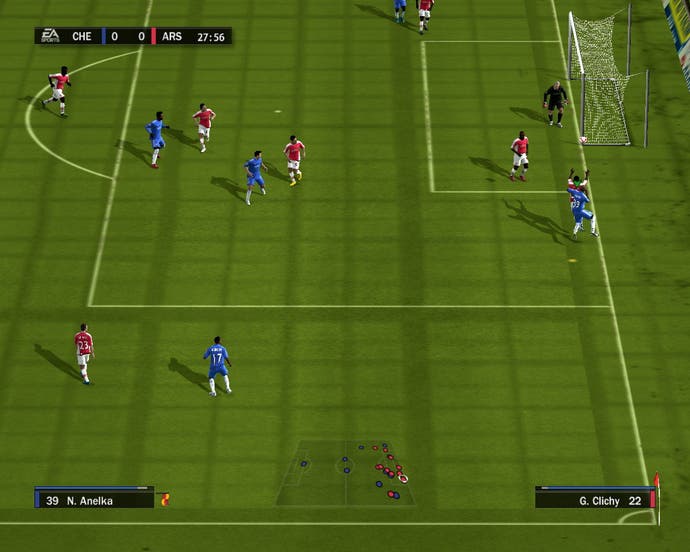FIFA 10
It's there.
In 1986, my beloved Liverpool were rampant: already 16-times First Division champions, FA Cup holders, four-time European Cup winners, with Ian Rush leading the line and Kenny Dalglish in a manager's seat embossed by our first ever double the previous season. The subsequent decline throughout the nineties was largely self-inflicted, but it didn't help that a sweary Scotsman had arrived at Old Trafford, and started making good on his promise to "knock Liverpool off their f***ing perch".
Pro Evolution Soccer finds itself in the Liverpool role these days. Demoted to second-best in 2008 after a few years of increasing stagnation, Konami will not enjoy FIFA 10. Conflicting embargoes mean that we can't put the two latest instalments head to head until our PES 2010 review on 15th October, but unless something dramatic has happened since last month, the gap is ever more significant. If last year saw FIFA knocking PES off its perch, this year it's chasing it around the birdcage with a plank of wood and a sledgehammer.
FIFA 10's 360-degree control is the key revelation. FIFA 09 still worked on diagonals - although not in such a pronounced way as PES 2009, to the latter's cost - but you don't realise how restrictive that was until you've played FIFA 10 for a few hours and try to go back. You can angle runs, shots and passes to your exact specifications, and it makes the world of difference to a game that was already a splendid simulation of the real thing. It's tempting to say that if FIFA 10 was simply FIFA 09 with 360 degrees of control, it would be worth that elusive ninth mark out of 10 anyway.

But that's not quite true - EA Canada did have some work to do, and while the range of refinements isn't all that sexy, it is meaningful. Ball physics remain excellent, with passes and shots accelerating and slowing with believable zip and inertia, but the ball is no longer so prone to ballooning over the crossbar, and cross-field passes are flatter and faster.
Balancing changes also have widespread repercussions. Pace is no longer as potent as it was in FIFA 09, for example, and this not only affects top-level strategy - you need to move the ball around to tempt players out of position instead, or use a bit of imagination and flair - but it closes off loopholes, so you can't simply rely on lofted through-balls, and winning a corner no longer leaves you so vulnerable to breakaways. At the same time, these changes are deftly managed, so fast-moving players remain influential, just not ludicrously so.

Another key factor in settling last year's nearly excellent game down a bit has been programming in suitable margins of error. For example, in FIFA 09 a tall player who won a header in the box generally scored. FIFA 10 understands that he may be under pressure that puts him off scoring, or he may be poorly positioned to score, or he may actually be rubbish at heading despite his height (I'm looking at you, Former People's Hero Peter Crouch).
It's true of shots in general, but the flipside of the issue is that outlandish goals and delightful, long-range, last-minute screamers are also possible very occasionally, if the circumstances are right. Just as Neil Mellor will never score a more perfect goal than his Liverpool winner against Arsenal, which finally broke the back of The Invincibles, you may put down your friends in similar fashion. Knowing it can happen, even if it probably won't, is more than football games have previously been able to give us.



